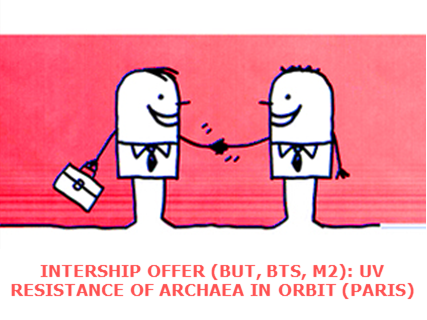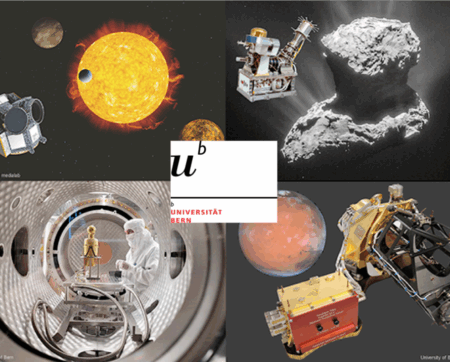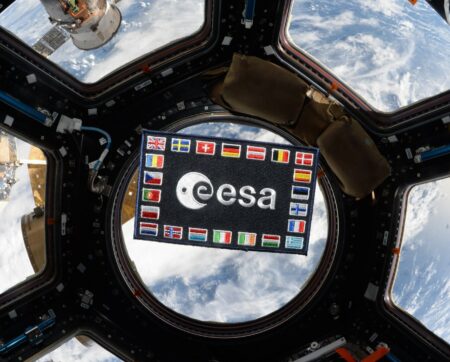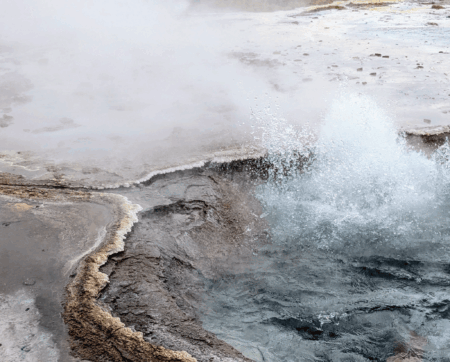Low Earth Orbit UV resistance in Halobacterium salinarum: Protocol validation tests and preliminary ground-based study
We are proposing an experimental internship to (i) validate the protocols to be applied to the Exocube spaceflight experiment, and (ii) provide essential preliminary data prior to launch of the experiment to the International Space Station. The project is based in halophile microbiology combining survival enumeration, growth curves, UV-irradiation, fluorescent labelling of cells, bulk fluorescent measurements using a multiwell plate reader and epifluorescence microscopy. This 3-6 month internship offer is applicable to BUT, BTS, M2, or candidates from other training programs with a strong technical background. Candidates should have prior experience in microbiology and theoretical knowledge of measurements of relative fluorescence intensity and epifluorescence microscopy, prior practical experience in microscopy is an advantage.
Location: UMR7245 MCAM (Molécules de Communication et Adaptation des Micro-organismes), Muséum National d’Histoire Naturelle, Paris France
Supervision: Dr Adrienne Kish, with the participation of doctoral researcher Elisa Ravaro
Background: Halophilic archaea such as Halobacterium salinarum (H. salinarum) are resistant to desiccation and hypersalinity, surviving entombment within the fluid inclusions of halite (NaCl) crystals. They are also known to be resistant to space-relevant conditions such as high vacuum, UV-C, and gamma irradiation due to specific molecular adaptations that protect and repair damages to proteins and DNA1,2. While halophilic archaea have shown varying degrees of resistance to simulated and actual space conditions3, little data is currently available concerning the molecular-level effects of solar radiation exposure on their cell envelopes. The cell envelope of halophilic archaea is a simple structure but resistant to extreme conditions: a cell membrane composed of ether-linked lipids with isoprenoid chains surrounded by a proteinaceous surface layer (S-layer) of self-assembled into a symmetrical 2-D array. The structural stability and functioning of cell envelopes in establishing chemical gradients and participating in redox reactions are essential for cell viability. As part of the ExocubeHALO project, we are investigating the effects of space solar radiation on the survival of H. salinarum entombed in halite crystals. The end goal of this project will be to include theses samples into the international Exocube project lead by Dr Andreas Elsaesser for exposure to the solar radiation environment in Low Earth Orbit (LEO) outside the international space station. Preliminary miniaturization and space readiness of the technology for Exocube has been done4,5 and the final flight hardware is currently in testing and final preparations. Exocube will be included in a package of exposure experiments from the European Space Agency on the new Bartelomeo platform outside the Columbus module of the International Space Station. Preliminary work in our lab has already established protocols for halophile sample preparation and a library of fluorescent probes to investigate H. salinarum cell envelope integrity and function.
Project: The intern will perform microbiology investigations to determine the survival limit of H. salinarum to LEO UV radiation. Both liquid cultures and evaporated cultures of H. salinarum entrapped within halite brine inclusions will be exposed to full UV irradiation (200-1100nm) using solar simulator equipped with a high-pressure xenon-arc lamp. Survival will be measured by CFU plate counts and growth curves in hypersaline liquid media (cuvette and microwell plate protocols). After the UV dose survival rates have been established, halite containing H. salinarum will be rehydrated in growth media containing fluorescent probes, and measurements of fluorescent intensity will be performed to measure the effects of UV-irradiation on the H. salinarum cell envelope. Bulk measurement will be performed using a multiwell plate reader and correlated to cell-specific observations by epifluorescence microscopy. The deliverables of this project will be (i) establishing dose limits for LEO UV exposure of H. salinarum, (ii) validation of the post-exposure fluorophore measurements, and (iii) provide preliminary ground-based control data. The data collected will be incorporated into the development of the Exocube experiment.
Candidacy: Interested candidates should send their CV and letter of motivation (mentioning all prior laboratory experience and relevant techniques which they have performed either as part of practical classes or in-laboratory experience), a description of their current training program, and grades from their most recently completed year of education. Application files should be sent to Dr Adrienne KISH adrienne.kish@mnhn.fr before Oct 31. Candidates will be selected on a first-come basis.
References
1.Kottemann, M., Kish, A., Iloanusi, C., Bjork, S. & DiRuggiero, J. Physiological responses of the halophilic archaeon Halobacterium sp. strain NRC1 to desiccation and gamma irradiation. Extremophiles 9, 219–227 (2005).
2.Kish, A. et al. Salt shield: intracellular salts provide cellular protection against ionizing radiation in the halophilic archaeon, Halobacterium salinarum NRC-1. Environmental Microbiology 11, 1066–1078 (2009).
3.Mancinelli, R. L. The effect of the space environment on the survival of Halorubrum chaoviator and Synechococcus (Nägeli): data from the Space Experiment OSMO on EXPOSE-R. Int J Astrobiol 14, 123–128 (2015).
4.Sgambati, A. et al. SPECTROModule: A modular in-situ spectroscopy platform for Exobiology and Space Sciences. Acta Astronaut 166, 377–390 (2019).
5.Elsaesser, A. et al. SpectroCube: a European 6U nanosatellite spectroscopy platform for astrobiology and astrochemistry. Acta Astronaut 170, 275–288 (2020).





Aucun commentaire sur l'article Internship offer (BUT, BTS, M2) on Low Earth Orbit UV resistance in H. salinarum